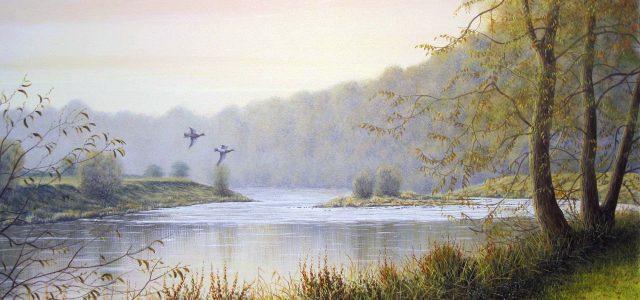
Meandering Ribble
Historian and fellwalker Andrw Stachulski follows the River Ribble on its journey from Ribchester to the M6
Let’s celebrate today the river which gives this magazine its name and remember how fortunate we are to have such a fine river as the Ribble on our doorstep. In particular, the section between Ribchester and the M6 has its own special character – here the river seems to sense the end of its journey not far away, as Wainwright says, and slows down in a series of graceful meanders, almost one mile wide near Balderstone.
This quiet stretch of the mature river seems a world apart from the M6 and the very busy A59, which run close by. There are footpaths which take you to both banks of the river, from Alston on the north side or Balderstone on the south, but they are remarkably little used. The banks are richly wooded in places and make a fine habitat for wildlife – deer, badgers and herons to name just a few.
The section also features some fine old halls along its banks, notably Osbaldeston, Hothersall, Sunderland and Balderstone. Of these Osbaldeston Hall is the oldest, with the present building dating from circa 1575 and extensively modified after the Second World War. According to Malcolm Greenhalgh, Hugh de Osbaldeston had built a much earlier hall on the same site in the late 12th century – the place-name has Anglo-Saxon origins. The present building occupies a lovely, parklike setting on the bank, depicted by Wainwright in his Ribble Sketchbook.
It was Hugh’s descendants, William and Adam, who later built Sunderland and Balderstone halls, further downstream from Osbaldeston. All three halls occupy similar ground, beneath a steep wooded slope, resulting in a sheltered spot which had plenty of timber on hand.
There was a ferry across the river at Osbaldeston, much less known than those upstream at Dinckley and Hacking Hall. It was used to ferry pupils to and from school in Ribchester and when the river was considered dangerously high it was stopped. Equally, if the river began to rise during the day, pupils could be taken home early! The old iron ring formerly used for the rope which moored the boat can still be seen in a rock on the riverbank.
Hothersall Hall, on the north bank of the river, was the ancient residence of the Lords of the Manor of Ribchester prior to the Norman conquest, but nothing remains of the earlier building. The present building is Victorian, dating from 1856, and was extensively restored in 1998. Also on the north bank, further downstream, lies Alston Old Hall, possibly dating from the early 15th century, with some of the original structure still discernible. Barely half a mile away north, going towards Longridge, is the Victorian Alston Hall, in Gothic style, which for some 40 years was a popular adult college and training centre for many kinds of activities. It became too expensive for the county council to maintain, and was sold in 2016, becoming a private residence once more.
As the long meanders continue, our leisurely, imaginary boat journey continues downstream, passing within just over a mile of Salmesbury Hall as the crow flies, at one point. The original hall was much closer to the Ribble, and further downstream – the building is marked as Old Hall on the OS map, by Elston. Much less imagination would be needed to hear the incessant drone of the M6 traffic as we draw ever nearer to the carriageway. It’s a sobering thought that this, the Preston bypass, was the first section of British motorway to be opened, in 1958. I wonder how many could have envisaged today’s motorway network?
However, the environs have been greatly enhanced recently by the opening in 2011 of Brockholes Visitor Centre, run by Lancashire Wildlife Trust, situated on a section of the Ribble flood plain. The local wetlands make a splendid habitat for wildlife, possibly best seen during the spring and autumn passage seasons, with many waders and birds of prey to be seen. Hobbies, ospreys, great crested grebe and egrets – look up their website for a full list of sightings. The site is easily accessed from the motorway junction roundabout and makes a good family outing.
West of the M6, the Ribble still has several miles of its course to run. For historic interest, fine buildings, wooded riverbanks, wildlife and a graceful mature stream. However, this section is some of the best the Ribble has to offer. Definitely worth your exploration.
Bibliography:
‘Ribble river and valley: A local and natural history’ M. Greenhalgh (Carnegie Publishing, 2009)
‘A Ribble Sketchbook’
A. Wainwright
(Westmorland Gazette, 1980)
Andrew Stachulski is co-author with Helen Shelmerdine (nee Shaw) of ‘The Forest of Bowland’, published in 2015 by Merlin Unwin @£14.99

